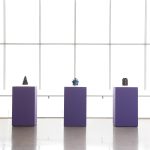The Institute for Contemporary Art at Virginia Commonwealth University (ICA at VCU) is pleased to present So it appears, an exhibition featuring nineteen artists from around the world whose works appear inscrutable at first glance—but upon closer examination, tangible, acutely urgent narratives begin to emerge. Grappling with the paradox of how to represent the un-representable, the collected artists have surfaced abstraction as a visual strategy—a tactic for encoding, encrypting and indexing otherwise invisible realities and disasters, as well as speculative futures. Installed in multiple galleries and spaces at the ICA at VCU’s iconic building, So it appears, will run from February 24 through July 16, 2023.
Organized by ICA Senior Curator and Director of Programs Sarah Rifky and ICA Curatorial Fellow Yomna Osman, So it appears is a site to research and explore tactics and narratives, to question how we usually see things and to find new methods for looking. The exhibition will present works from the following artists: Lawrence Abu Hamdan, Monira Al Qadiri, Alexander Apostól, Navine G. Dossos, Torkwase Dyson, Basmah Felemban, Žilvinas Kempinas, Agnieszka Kurant, Dinh Q. Lê, Jeewi Lee, John Menick, Novo (Reynier Leyva Novo), Trevor Paglen, Walid Raad, Tomás Saraceno, Pak Sheung Chuen and Levester Williams. Tasmania-based artist Tricky Walsh and New York–based audio artist and producer Sharon Mashihi will also be in residence throughout the exhibition’s run and will produce new works to be presented on April 21st on the occasion of the ICA’s fifth anniversary.
Formal abstraction, color fields and conceptual minimalism act as repositories for stories of carcerality, injustice, enslavement, the invisibility of migrants, environmental racism, and sonic warfare, among others. Though created at different times (from 2004 to the present) in vastly disparate contexts across fourteen different countries, the works collected in So it appears reveal surprising affinities in their approaches, subtleties and associations. Seen together, they invite us to reflect on the interconnectedness of the manifold global crises they speak to individually.
Navine G. Dossos’s paintings use the formal principles of Islamic geometry and contemporary Aniconism to covertly picture journalist Jamal Khashoggi’s assassination, emphasizing the silence, secrecy and visual opacity in media coverage of his murder. In a piece by Agnieszka Kurant and John Menick, line drawings by several “Mechanical Turks” (the 500,000+ home-based global workers organized into a freelance pool by Amazon, to whom one can outsource basic online tasks for just a few cents) gesture to the atomized, anonymous, radically underpaid labor hidden within that megacorporation. On the other hand, Lawrence Abu Hamdan uses “sound-images” to help viewers “see” the clandestine sonic warfare perpetrated in Lebanese airspace and the overlooked psychological effects on the people living below. In other works, aesthetic techniques like color-field painting or conceptual minimalism are deployed to surreptitiously deliver stories of incarceration or enslavement, the unseen experiences of migration or environmental racism.
So it appears is a site for the viewer to research, explore and test their own perception, questioning how we see and approach each artwork as a repository. The exhibition features forty artworks spanning urgent social, historical and ecological issues, and creates associations between them.
Press release from The Institute for Contemporary Art at Virginia Commonwealth University.



